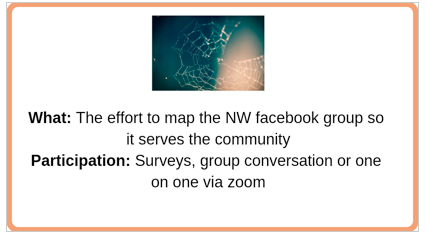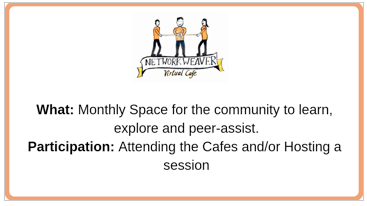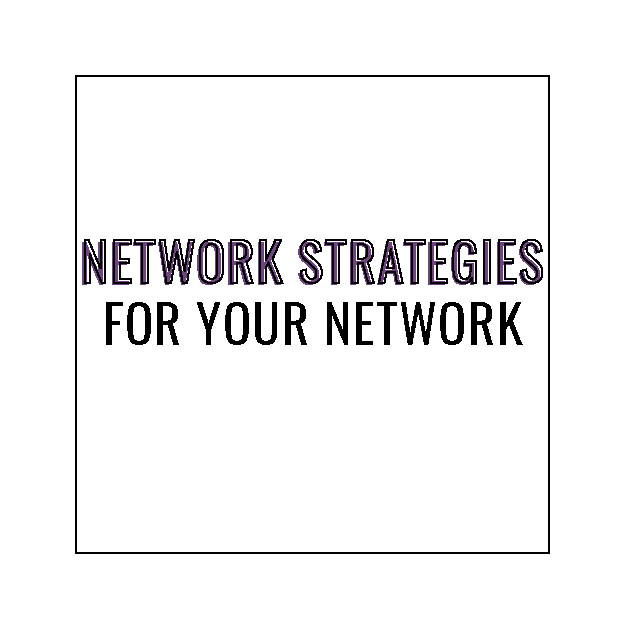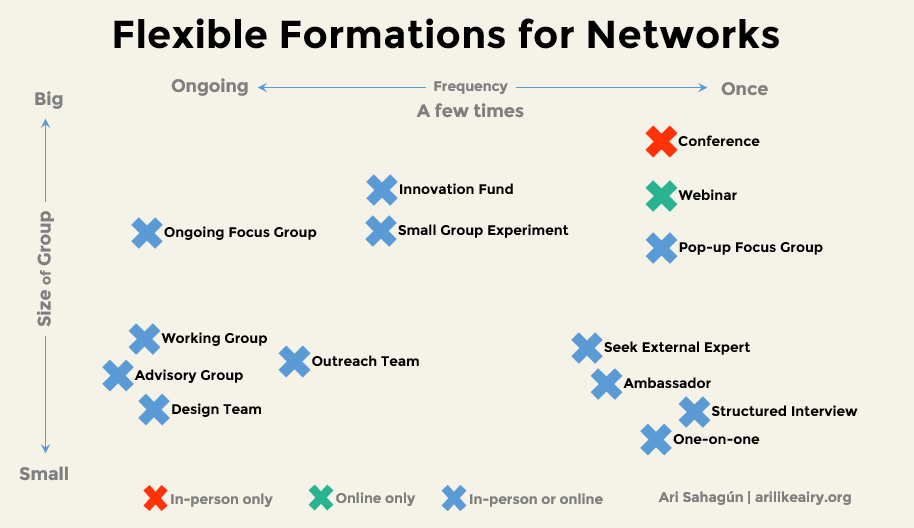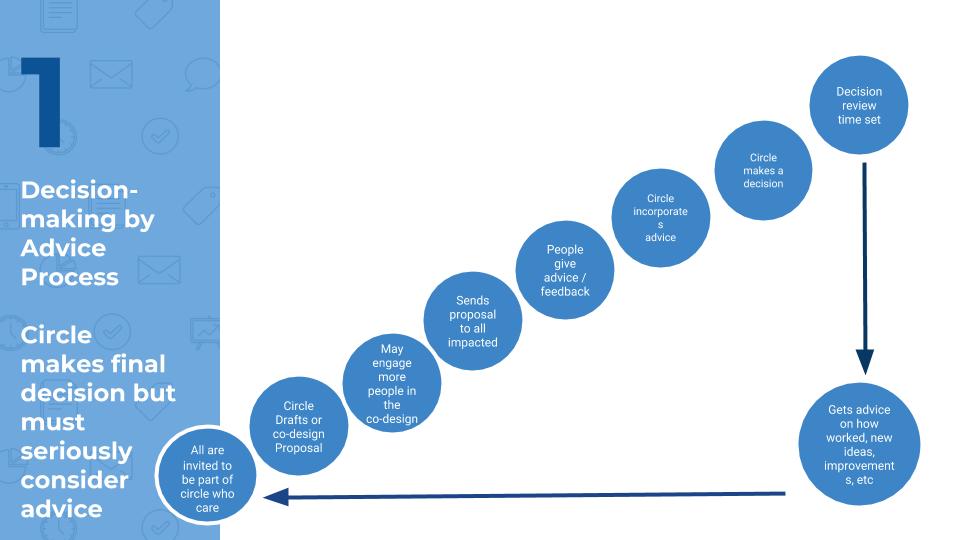Iniciandose En La CAJA DE HERRAMIENTAS De La AUTO-ORGANIZACIÓN
Spanish translation by Ulises Aguila
( for the English language version of the Self Organizing Toolkit click HERE )
Iniciandose En La CAJA DE HERRAMIENTAS De La AUTO-ORGANIZACIÓN incluye un conjunto de simples acciones que usted puede tomar para comenzar uno mismo-organización en tu organización o red.
La auto-organización sucede cuando cualquier individuo o agrupación:
- Visualiza una oportunidad para hacer un cambio o tratar de hacer algo diferente [ap_spacing spacing_height="10px"]
- Siente que puede iniciar una acción[ap_spacing spacing_height="10px"]
- Encuentra diferentes aliados de redes más grandes para buscar unirse o colaborar
- Experimenta poniendo en marcha acciones pequeñas
- Accede a los recursos que necesitan intervenir[ap_spacing spacing_height="10px"]
- Pasa el tiempo necesario observando atentamente lo que está sucediendo, resumiendo, aprendiendo de esa experiencia y analizado lo que se ha hecho, todo esto para empoderar de una mejor manera el siguiente paso[ap_spacing spacing_height="10px"]
- Comparte lo que ha aprendido con una red más grande[ap_spacing spacing_height="10px"]
Weaving the Weavers : Efforts to co-create global learning and peer assist
[ap_spacing spacing_height="20px"]Let´s be honest Network Weaving is super fascinating. There are so many activities that we, network weavers, can contribute to to make communities vibrant and effective. Surely, you have your own story and connection to what got you into network weaving. We can seize modern technologies to connect and and share these stories and our learnings.
There is a Facebook group called Network Weaving that currently has about 1800 members. There already has been a vivid exchange of resources and learning through posts and comments. At the beginning of this year some members began further deepening the potential of this amazing community. There are efforts to build a network map and the establishment of regular online formats. In this blog post I will give a short overview of what has been happening so far and how you may participate in the journey.
[ap_spacing spacing_height="20px"]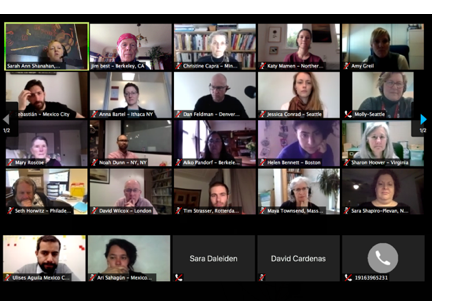
[ap_spacing spacing_height="20px"]
Purpose and Needs
Both the mapping efforts and the virtual cafe identified the needs in the community. Both groups found similar themes and purposes, which cover:
- To help the community discover its identities, building trust-based relationships, and encouraging/facilitating collaborations and learning.
- To further build the field of network weaving, understand its potential and role in systemic change.
- To deepen information flows, to connect related capacities and to attract more abundance to our work.
[ap_spacing spacing_height="10px"]
What has been happening
The network mapping journey
The journey to create a useful network map is highly participative and members of the network weavers facebook group are encouraged to join in any step of the process that is the right fit for them. There are three distinct phases that we are working through; First, we are taking the time to envision and get a better sense of what the community wants, needs and values. Once we have that clarity we’ll move into a technical phase where we’ll build the map. Finally, we’ll work together to make sense of what we are seeing in that map. We kicked off the envisioning phase with twenty seven members of the Facebook group in a zoom session with the larger group having been invited to contribute their perspective in a survey.[ap_spacing spacing_height="10px"]
The Master Mappers have extensive experience with network mapping. Christine Capra, Sarah Ann Shanahan, Maya Townsend, Lisa Negstad, Jim Best and Drew Mackie serve with their efforts and knowledge to facilitate learning, increase the awareness regarding passions and relationships within our community, and to develop the mapping skills of network weavers. This is the process of the mapping and as you see you can work closer with the Master Mappers, fill in surveys and attend the convenings.
[ap_spacing spacing_height="10px"]
Next Meeting on the 2nd April 9:00 -10:30 a.m. CT
Register at:
https://zoom.us/meeting/register/3e12488a815da90c8c34be5db4a05ad8
[ap_spacing spacing_height="20px"]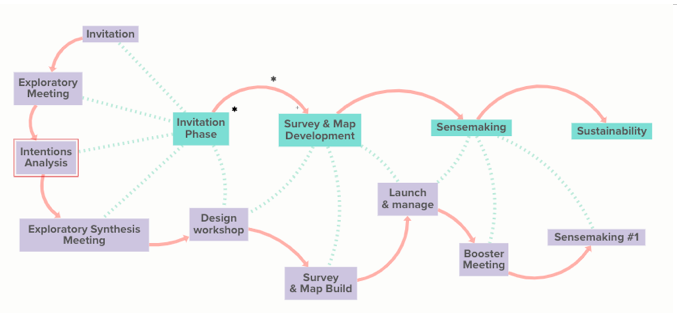
[ap_spacing spacing_height="20px"]
The Virtual Cafes, hosted by an open group of facilitators each month, aim to intensify learning, peer assistance and our service to systemic changes. There have been two cafes so far and the next one is coming up at the 4th of April. The hosts are currently Tim Strasser, Nenad Maljković, Ben Roberts, Jim Best, Keala Young and Adrian Röbke. The hosting group is open. Whomever wants to contribute is very welcome! In the last cafe on the 7th of March we explored our learning wishes and already dove into some of them in an open space, which is one of the many interactive formats we will use to have fun. These wishes to which you can add anytime are a basis for further explorations and journeys.
[ap_spacing spacing_height="20px"]
Event Link: https://www.facebook.com/events/248389826079525/?event_time_id=248389829412858
So this is about it. Personally, I feel lots of excitement and curiosity about what we can co-create as a global community. After just three gatherings I have made lots of good connections and I am sure that really cool ideas will emerge when we get together! Looking forward to seeing and hearing you soon!
[ap_spacing spacing_height="10px"]
Adrian Röbke
[ap_spacing spacing_height="20px"]
Photo by Kyle Glenn on Unsplash
Transformative Networks Are Multiscalar
[ap_spacing spacing_height="30px"]
This is an excerpt from the Network Weaver Handbook. I'll be writing an update with my latest research and thinking on the topic in the coming weeks so stay tuned! - June Holley
[ap_spacing spacing_height="25px"]
How does transformation of our systems happen?
In the 1950s, researchers developed a model of the diffusion of innovation where, when influential individuals adopted an innovation, that practice or idea would spread rapidly among the rest of the population. In this model – still favored by many marketing strategists – all you had to do was to identify influential individuals, convince them that your product was superior, and their influence would ensure that many other people adopted your product. The adoption of the use of hybrid seed corn in the 1950s and the fad of hula hoops were touted as successful examples of this type of innovation diffusion.
"The critical question is whether an how social networks can help facilitate innovation to bridge the seemingly insurmountable chasms that separate local solutions from broad system transformation."
- Michele - Lee Monroe and Frances Westley
More recently, Duncan Watts, a researcher in the area of complex networks, refuted this simple approach to the diffusion of innovation. He showed that whether an idea or practice is spread by an influential person is highly probabilistic – sometimes spread happens and sometimes it does not. Spread depends much more on the kind of network surrounding the innovation than on the kind of individual advocating an innovation. For example, if networks bridge across clusters so that there is now a larger network, innovations can flow to a larger set of practitioners. Also, networks where people are working in many projects, each with somewhat different participants, are likely to see innovations spread quickly. When a useful innovation arises in one project, the individuals in that project are likely to tell all their other projects about the innovation.
"Scale the edge, not the core."
"Building on this, we have discovered that creating multiscalar networks – networks that cross levels or layers – are what turns innovation into widespread systemic transformation. We have identified specific patterns of 3 layers of interconnected networks that can bring about this transformative effect. People working in an issue or vision area need to make sure that they are part of all three if they want maximum impact.
- Level 1: Build local networks for experimentation
- Level 2: Build networks for scaling out so that local innovations can spread, inspire, and learn from others
- Level 3: Build networks for scaling up so infrastructure and policy to support innovations can be developed
LEVEL 1: Local Innovation Networks to experiment
"Scaling across happens when people create something locally and inspire others who carry the idea home and develop it in their own unique way."
-Margaret Wheatley, Walk Out Walk On
Chapter 10 described the process for creating a maximally innovative local network. However, there are two additional aspects of local networks that enable them to effectively link to networks at other scales:
- Development of an effective periphery for spreading ideas
- Expansion or spread of local networks for increased impact
The phrase, “Scale the edge, not the core,” describes the importance of developing an extensive periphery for your local network. Much of that periphery will be located outside of the local community. People in the periphery who help the local network be maximally innovative are:
- People in other communities around the world working in the same issue or vision area who can offer new ideas and practices
- People in other communities who are interested in what the local community is doing
- People who are connected to other disciplines or sectors and might have new insights or identify ways the two sectors could combine efforts
Another aspect of local innovation networks is that they encourage local groups to obtain a more sophisticated understanding of the entire system that their issue is embedded in and encourages them to work with others to address issues systematically. So, for example, a network working on prison reform might start to work with jobs programs and entrepreneurship organizations to develop better re-entry programs and, at the same time, work with a community development network on ending racism-related sentencing.
Many local food system networks have joined with artisan organizations and other local businesses to create healthy local economy initiatives. Other local food system networks have expanded their network to include those working on anti-obesity efforts. Transformation begins as projects increasing connect with projects working on other aspects of the system, thus amplifying their impact. Other fields (immigrant reform, criminal justice, reproductive rights, poverty, etc.) could all benefit from this type of local expansion of their networks.
Activity: Expanding your local innovation network
On chart paper or large whiteboard, have people in your network identify organizations and individuals they could add to their periphery to access new ideas. Then, using another color have them identify organizations that are interested in their local experimentation and with whom they might share what they are learning. Identify individuals in the local network who will seek out and/or stay in touch with each.
Using another color, identify local organizations from somewhat different fields but interested in some of the same problems or issues with which they might have discussions on how they could work together. Determine which are the highest priority. Who will reach out to them?
LEVEL 2: Scaling out networks
"Information can leap from group to group even when those groups seem to have nothing in common, because all they need in common is a single individual who is member of both groups and therefore has a bridging identity."
-Paul Hartzog
In the 20th century, many foundations funded efforts to replicate best practices. We know now that replication is an inadequate concept for the complexity of social problems we are working with for three reasons:
- Most projects need to be adapted to each specific community to be fully effective.
- Most projects can still be improved and so shouldn’t be replicated slavishly.
- Specific projects are still only one piece of a very complex problem or system and without integrating a number of system elements at the same time project success is likely to be limited.
Still, there is a lot of great experimentation happening in communities. For other communities to benefit from this requires a scaling out network. A scaling out network has four different aspects
- Support the spread of innovations
- Develop systems for determining which local efforts are worth scaling
- Support learning clusters of organizations working on similar strategies
- Support rhizomatic acceleration: research, venues, and leadership for scaling out
1. Scaling out by supporting spread
People in local networks need to be encouraged to share information about their innovations wherever they go. Funders need to provide incentives for successful innovative projects to coach other communities as they adapt that innovation (see the Saving for Change example below). Funders might have grantees suggest groups/networks they want to learn from, then help these identified innovators set up training sessions, site visits, or coaching.
Actually much informal sharing is already occurring, and it would be valuable to identify groups or individuals who have been very successful at informal sharing and document their methods and practices through case studies.
One of the best ways for people to learn about innovations is through stories about those innovations. The success of the RE-AMP case study by the Monitor Institute shows that there is a huge need and market for high-quality case studies. In fact, it would be great to have web sites where sets of case studies were collected, along with notes from conversations people had with each project so that a deeper and more complex perspective is available. People need to be able to take a “deeper dive” into the case study by asking questions of those involved in the innovative project or network. If such sites also had discussion forums, then we would be able to easily see which projects appeared to be attracting a lot of attention and funders could direct more resources to those innovators
2. Scaling Out By Developing a System for Identifying Projects for Scaling
Not all projects are worth scaling. How can projects be evaluated to help others determine whether they are effective? Initially, promising projects may not show clear outcomes but will have deeply embedded processes for reflection and learning that will enable them to continue modifying their approach until it produces results.
We need Network Guardians who are exploring issue areas at a meta-level, identifying projects that are tackling similar problems but using different approaches and noticing those projects that, in addition to showing early promise, appear to have a lot of energy and attraction.
The United Nations (cited in Critical Choices by Reinicke and Deng) calls this role a network entrepreneur. A network entrepreneur identifies niches where conditions are right for launching new global public policy networks and takes steps to initiate formation of a new network. Foundations and national networks could also help identify areas where scaling could be most beneficial. BALLE is an example of a national network that is identifying a variety of innovations that can fill the need for local access to local capital for local businesses.
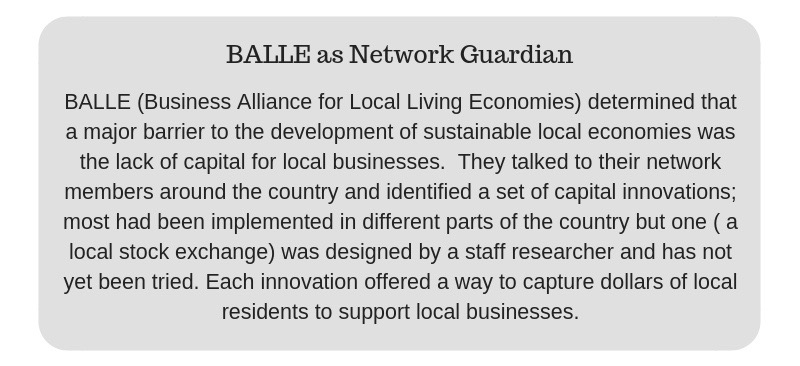
3. Scaling Out Through National Learning Clusters
Learning clusters are one of the most underused and underfunded strategies for scaling projects. They are the second level in a multi\scalar network and critical for transformation. A learning cluster is a set of local network projects from different communities whose participants are brought together regularly (virtually and/or face-to-face) to share about strategies they have developed, build skills, and learn from each other. It is through intensive reflection by these initiatives that key leverage points for system change can be identified for an entire issue area.
Clusters can be composed of innovative network projects that are already underway or of local networks just embarking on a strategy (or, ideally, mixtures of both). In most cases, each project will be unique: variations among the strategies, in fact, are encouraged so that participants can continually learn from each other.
Three critical ingredients of learning clusters are:
- Highly skilled facilitation
- Attention to building deep network relationships among the participants
- Diverse participants from each participating local network (different types of organizations, individuals of different ages and backgrounds)
In learning clusters, projects are introduced to the innovations of other groups, and at the same time, the cluster as a whole looks for the critical elements among all their projects that lead to success. Clusters can provide peer assists (sessions where one project outlines a challenge and the other projects ask questions, give ideas and advice, and share information about resources). Each local group also gets assistance from the rest of the cluster as they adapt model projects from other cluster members to their particular locale. The entire group also provides support for each local project as it continually improves and refines its strategy.
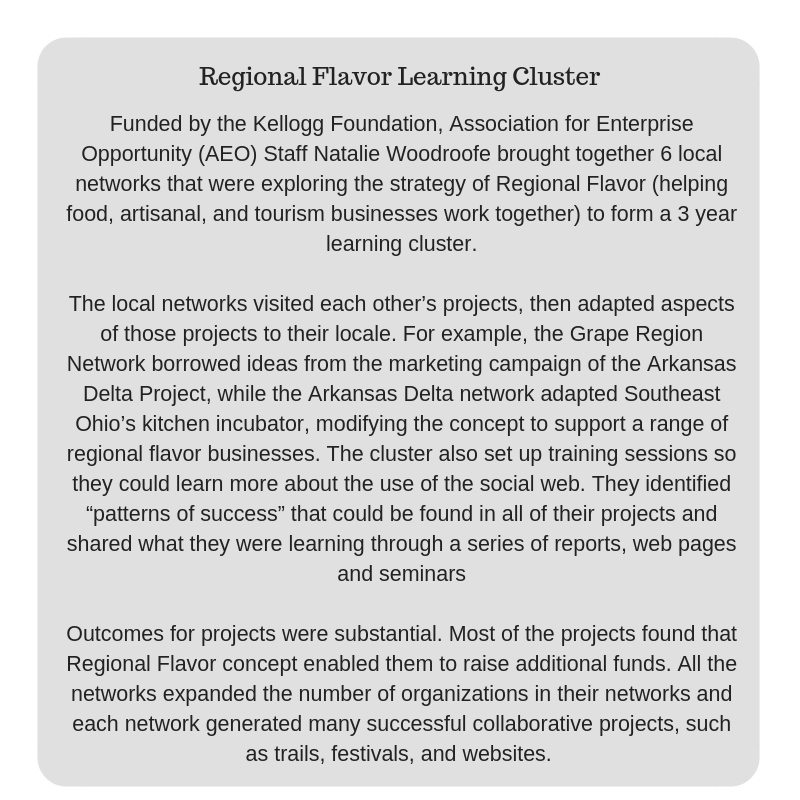
Many learning clusters that have been set up by funders have not been successful because the local projects have not been the initiators of the convenings and have not been able to have a say in the selection of their learning partners. Learning clusters take surprisingly few resources to operate, but dissemination of findings to larger groups in the field and handbooks that capture the cluster’s recommendations on implementation both need to be part of the overall project.
Activity: Create A Learning Cluster
- Identify 6 to 12 organizations working in your issue area that you would like to learn more about.
- Have sets of twosies in your network, select an organization each to call and interview.
- Identify the ones that are most innovative. Find out if they would be interested in being part of a learning network.
- Identify a source of funds to support coordination of the learning clusters.
4. Scaling out by supporting Rhizomatic Acceleration: Research, venues, and leadership for continued scaling out:
The concept of rhizomatic acceleration is key to successful scaling out. When we study a ginger rhizome we learn that every bud of ginger has the nutrients to generate and support many other buds. As a result, ginger rhizomes can expand rapidly without any central authority (see photograph below).
How do we implement a rhizomatic approach?
- We ensure that all Network Weavers learn how to help others become Network Weavers.
- We make sure that individuals who are part of collaborative projects are made aware of the skills, processes, and platforms that are being used in that project, and are encouraged to use these in other projects of which they are a part.
- We make sure that network participants have many platforms and venues for sharing what they are doing in ways that others can adapt their innovations.
In addition, research teams (including practitioner and professional researchers) using a developmental evaluation approach need to be embedded in learning clusters from the start so that they can record what is happening transparently and as the learning cluster is unfolding. Developmental evaluation uses a complexity lens to understand what is being developed through innovative engagement.
By sharing information and insights as the learning cluster progresses, other local networks can be adapting what is learned in their locale even before the learning cluster has concluded. Webinars, gatherings that piggyback on conferences, and interactive websites – all can become venues for sharing out what is learned in the clusters.
In addition, participants in the first learning cluster could then become coaches and trainers in a second, larger learning cluster. In this way, learning clusters become rhizomatic accelerators to the extent that the initial participants become skilled at and willing to share what they have learned with other local networks.
Like ginger, where every node has the nutrients to support the budding off of many other nodules, learning cluster participants need to be encouraged and incentivized to help many others adapt their strategies (see Michael Quinn Patton’s Developmental Evaluation
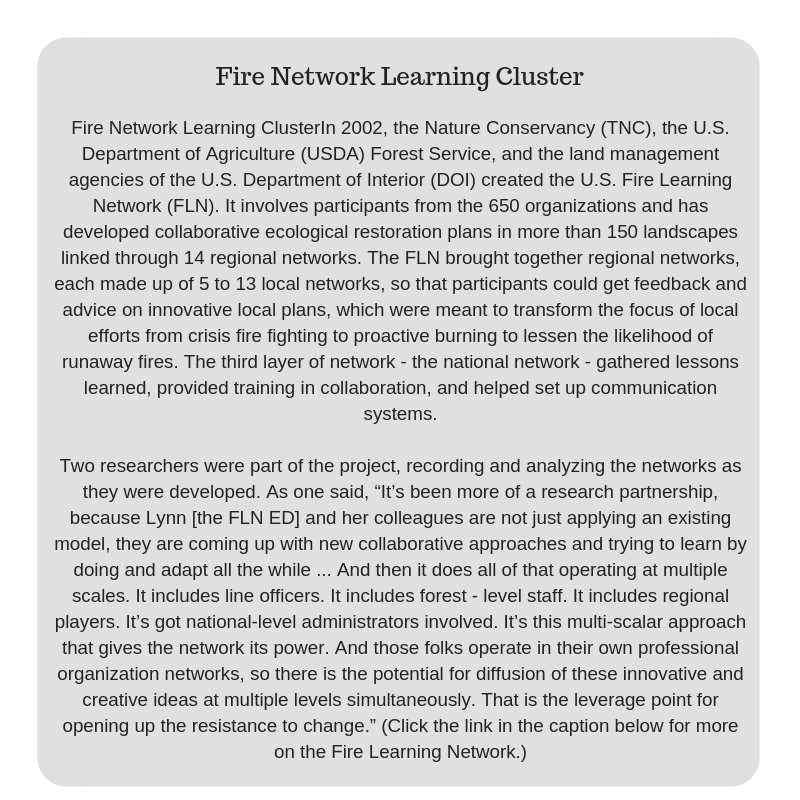
[ap_spacing spacing_height="40px"]
LEVEL 3: Scaling Up
Transformation is unlikely to occur simply by having many communities adopt innovations. Not enough communities will find out about the innovation, not enough resources will be available even for those communities that do want to adopt innovation, and not enough connections among the innovations will occur for a tipping point to be reached. In addition to scaling out innovations, scaling up mechanisms need to be set in place.
Scaling up is the use of policy, platforms, strategy, and meta-networks to accelerate the spread of innovation. Scaling up has typically been accomplished by control-based mechanisms. Often corporations scale up by creating franchises (think McDonalds) where each local fast food restaurant is identical to every other unit – with all units controlled by a central office. This method of scaling up can produce rapid growth and substantial profits, but has resulted in many unintended consequences such as our current obesity epidemic with its horrific impact on quality of life and skyrocketing medical costs.
Another example is the No Child Left Behind legislation which mandated a system of testing for school children and led to “teaching for the test.” This policy required all schools to operate in this way and is an example of scaling up through control and homogeneity. The problem with this path to scaling up is that mandated policies don’t always accomplish their intended goals – as has recently been shown by the flat test scores for all grades. When this happens, our entire society suffers. “One size fits all” policies are seldom successful for issues as complex as education, since students and their communities vary so greatly that a single policy is unlikely to work everywhere.
Network systems offer a healthier and more useful model for scaling up, especially in situations where we are grappling with complex problems and systems: Regional or national meta-networks. A meta-network is a network of local or regional networks. Such networks enable rapid scaling up through the use of:
- System analysis for identification of leverage points
- Network Guardians
- Clustering into working groups or action groups to focus on leverage points
- Pooled funds
- Communication platforms
- Policy networks
The time is right for the formation of more intentional meta-networks for many issue areas. We now have enough experience with networks so that we can create structures that are likely to succeed, and the potential to increase impact is great.
Support for meta-networks
Scaling up is best accomplished through regional, national or international meta-networks that focus on a particular issue, problem, or system development area. Meta-networks can either be formally organized, as in the case of RE-AMP, or informally organized, as is the national network focused on supporting local food systems.
Informal Meta-Networks
In an informal meta-network, an organization or set of organizations playing the Network Guardian role identify innovations, convene learning clusters around those innovations and access resources for organizations/local networks in the clusters, and then share out the learnings generated by the cluster. They set up funding pools to support the expanding numbers of local networks implementing this innovation and connect sets of learning clusters, each working on different aspects of the system, so that the entire system begins to shift.
As learning clusters unfold, they identify key system elements for success of that strategy and will come up against barriers that will need to be addressed. Many of these elements would be better implemented by a regional or national program requiring new policy to be enacted. An informal meta-network encourages the formation of policy networks to move support for innovations from foundations to government.
For example, the local PLAN networks, described below, discovered that to fully support people with disabilities, they needed to work together to develop a national program that enabled these individuals to save money for a home, education, or a business (without jeopardizing benefits). This required policy networks to be formed to set in place the necessary legislation.
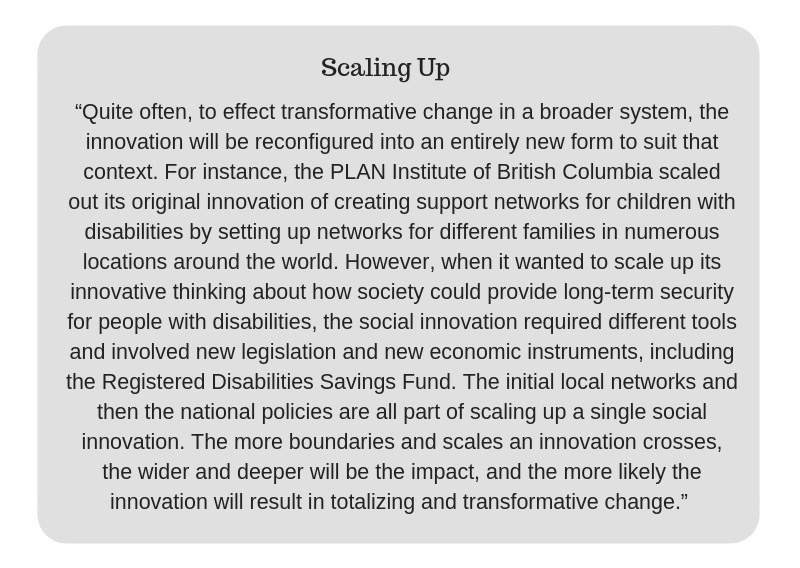
https://www.ecologyandsociety.org/vol16/iss1/art5/
Formal meta-networks networks
More formally organized networks such as RE-AMP set up networks with more explicit structures to help organize work. They have membership and formal structures – such as the Working Groups that RE-AMP set up – to organize the work. They have a set of platforms and venues for sharing information, from an interactive website to regular Working Group calls.
We encourage you to comment on this post so we can hear about your thoughts and experience.
A Network Connector Story
Sometimes a story can convey meaning better than a lecture. This week's free resource is a story from the early days of the Appalachian Center for Economic Network's (ACEnet) Kitchen Incubator describing how staff were network weaving small food producers in our region.
This focus on connecting people is important no matter what type of organization or network you are part of! We'd love to hear your network weaving stories.
A Network Connector Story
[ap_spacing spacing_height="20px"]
First, An Introduction [ap_spacing spacing_height="25px"]
For a long time, we've trained our eyes to see things with edges and boundaries: organizations, countries, selves. Things with edges and boundaries feel manageable and solid. [ap_spacing spacing_height="10px"]
But the world is changing at an alarming rate, and the old ways of seeing are not quite up to the vertigo of a fast-paced universe. We need new ways of understanding our world that take into account new possibilities. [ap_spacing spacing_height="10px"]
So, we start noticing networks –the relationships among people and the patterns those relationships create. Increasingly, we are realizing that it’s through networks that things get done. People go outside teams, organizations, and even countries to connect with those who can help them succeed. And, using social media, we can now collaborate and engage as easily with people around the globe as we can with people in our hometown. [ap_spacing spacing_height="10px"]
We soon start to notice that all networks aren’t the same. Certain patterns in networks, such as a hub and spoke, are great when you want control. But when you need lots of innovation and aren’t at all sure what will work, bringing together people from different networks who have different perspectives and backgrounds can generate transformative experimentation. [ap_spacing spacing_height="10px"]
But bringing together people effectively is not easy. It requires a whole set of new skills embodied in a new role we call a Network Weaver. A Network Weaver is someone who is aware of the networks around them and explicitly works to make them healthier (more inclusive, bridging divides). Network Weavers do this by connecting people strategically where there's potential for mutual benefit, helping people identify and join with others around their passions, and serving as a catalyst for self-organizing groups. [ap_spacing spacing_height="40px"]
A Tale of Network Connecting [ap_spacing spacing_height="20px"]
Nestled in the Appalachian foothills of southeastern Ohio is the ACEnet Food Ventures Center, a kitchen incubator where people can rent the use of equipment to process specialty food products. The goal of the Center is to help as many people as possible start local food businesses, even if they have very little money (as is the case for many people in this region). [ap_spacing spacing_height="10px"]
From the start, ACEnet staff knew they did not have the resources to provide entrepreneurs with the assistance they needed to be successful, so they developed another strategy. They spent much of their time strategically connecting entrepreneurs with each other. Here’s a typical scenario. [ap_spacing spacing_height="10px"]
It was a blue-sky October afternoon in 1995, and Bill –network weaver extraordinaire –was standing on the loading deck of the newly completed kitchen Incubator where start-up entrepreneurs came to make their specialty food products. Craig, from Frog Ranch Salsa, was loading cases of his award-winning product into his truck and grousing about the high cost of jars. [ap_spacing spacing_height="10px"]
Right then, another truck pulled up to the dock, and Betty – one of the owners of another salsa producer – hopped out and started unloading cases of empty jars that would be filled later that day. Bill immediately introduced Craig to Betty, encouraging them to compare notes about the quality of tomatoes that season and local bands that were playing in town that weekend. [ap_spacing spacing_height="10px"]
Network Weavers are continually making connections between people –but they are always connecting strategically. They point out commonalities that create a foundation for mutual benefit. They also help people figure out if they have the kind of personal and emotional connection that will enable them to do things together. [ap_spacing spacing_height="10px"]
The two were now laughing and joking, so Bill introduced an opportunity. They both used the same jar for their salsa. Couldn’t they order jars together and significantly lower the price? Craig and Betty both thought this idea had some real potential, so Bill helped them figure out how it might work. [ap_spacing spacing_height="10px"]
Network Weavers help people self-organize. They start with twosies –fairly simple activities that benefit both individuals. They coach rather than run the show. As a result, the two individuals are more thrivable: together they have freed up more money for their businesses and they now have a set of collaboration skills that can be used in many other situations. [ap_spacing spacing_height="10px"]
The first order worked out without a hitch. The next time Bill saw Betty, he suggested that they might want to include several other businesses who used the same size jars in the next order so they could lower the price even more. Soon the joint orders filled an 18-wheeler and the cost of the jars was one-third the cost they had paid when they ordered singly. Now they got it: they could come up with all kinds of ways that they could improve their business and the community, find others to join them and make something happen. In the next few years, the people involved in the jar orders became Network Weavers themselves and, with many others, organized two different festivals, a regional brand, a loan fund, a food policy council, an innovation fund and many more collaborations. [ap_spacing spacing_height="10px"]
Through modeling and coaching, Network Weaving encourages people to act their way into a new way of being. Network Weaving increases thrivability both for individuals and their communities as people gain the framework, skills, and processes they need to co-create wonderful communities. [ap_spacing spacing_height="10px"]
When people take on the role of Network Weaver, they take responsibility for working with others to create healthier networks. [ap_spacing spacing_height="20px"]
We encourage you to comment on this post so we can hear about your thoughts and experience.
[ap_spacing spacing_height="60px"]
Network Strategies For Your Network
This video is about 20 minutes long and provides a short overview of network strategies. It was done for the Food Policy Network State Networks, who graciously agreed to let me share it.
The video emphasizes the importance of being part of networks of networks and of catalyzing self-organizing to move us to a more experimental, learning and viral space.
Networks of networks and self-organizing are the key factors needed to shift systems.
[ap_spacing spacing_height="10px"]
Sociocracy: Why, What and Who?
An excerpt from Chapter 1 of Many Voices One Song: Shared Power with Sociocracy by Ted J Rau and Jerry Koch-Gonzalez
Sociocracy is a set of tools and principles that ensure shared power. How does one share power?
The assumption of sociocracy is that sharing power requires a plan. Power is everywhere all the time, and it does not appear or disappear - someone will be holding it. We have to be intentional about how we want to distribute it. Power is like water: it will go somewhere and it tends to accumulate in clusters: the more power a group has, the more resources they will have to aggregate more power. The only way to counterbalance the concentration of power is intentionality and thoughtful implementation.
Power, like water, is neither good nor bad. In huge clusters and used against the people, power will be highly destructive. Used to serve the people and the earth, distributed to places where it can work toward meeting the needs of the people and the earth, power is constructive, creative and nourishing like an irrigation system.
One can think of sociocratic organization as a complicated irrigation system, empowering each team to have the agency and resources they need to flourish and contribute toward the organization's mission. We avoid large clusters of power, and we make sure there is flow. Water that is allowed to flow will stay fresh and will reach all the places in the garden, nourishing each plant to flourish. Sociocratic organizations nourish and empower each team to have the agency to flourish and contribute toward the organizations' mission.
Power does not have only one source. In that respect, power is different from an irrigation system. All members of the organization feed their own agency and resources into the organization, in each team. Everyone contributes their power and relies on each other's power. From there, power, and with it, resources, gets distributed into the whole and gets channeled to where the group wants to put their energy. Sociocratic organizations keep everyone's own agency and power intact and support people to make changes bigger than they could have made alone.
In order to achieve this, our sociocratic organizations differ from organizations with aggregated centralized hierarchical power in two ways:
- We distribute power more evenly. Those who come with less agency get support to step into more agency. Those who come with more sense of agency contribute toward the whole without diminishing anyone else's power. Teams doing work together are empowered to contribute. [ap_spacing spacing_height="10px"]
- We let power flow. Flow means the distribution of power needs to be adjusted and potentially changed over time. The sociocratic organization is adaptable and resilient.
Building a system that distributes power by empowering everyone requires thought and intentionality. That is what sociacracy is: the design principles of distributing power in a way that flows with life.
1.1 The values under sociocracy
What kind of world do we want to live in? The way we answer this question is: We want to live in a world where people support each other, consider each other and help each other meet needs. A collaborative world.
1.1.1 Organizations are living systems
Organizations are designed in a way that fosters our connection with each other and with ourselves, both within and outside of the organization. To effectively create connections, organizations need to be life-serving and all-embracing. Life-serving means that we want to foster organizations that work for everyone in the organization and hold care for everyone affected by the organization. No one and nothing can be ignored if we want to honor connection.
We want to support living organizations. Living systems can be on any kind of scale: a cell is a living system as it creates a membrane, forms an identity and interacts as a whole with its outside. Organizations are living systems: they interact with their outside (clients, students, consumers, investors), and their members on the inside interact as information, goods, and energy are being exchanged. A system that does not let the organization breathe like a living system will constrain and muffle its unique expression of life. Living systems have characteristics that we want to be aware of:
- Living systems form a whole and can act as a whole. For example, a human body is a complex system of smaller complex systems, but it is perceived and acts as a whole.[ap_spacing spacing_height="10px"]
- Living systems are interdependent with their context. There are no isolated systems. However, many people in Western cultures have been conditioned to think individualistically, as if we were separate from our context and could ignore our impact on the world around us.[ap_spacing spacing_height="10px"]
- Living systems are interactive and open (within limits). An organism that does not interact with its outside will not be able to survive. Organisms provide a (permeable) "membrane" between their inside and their outside. This is the basis of identity and capacity to act.[ap_spacing spacing_height="10px"]
- Within a system, parts are interdependent, which means they rely on each other to meet their needs. This both true for parts of a cell and it is true for a society.[ap_spacing spacing_height="10px"]
- Living systems are dynamic, they are not static. They change over time as they adapt and change constantly. Living systems can learn and heal. They are resilient.[ap_spacing spacing_height="10px"]
- Living systems are inherently ordered, in their own way. A forest, for example, has an order. So does an organization - living systems are defined by the fact that they create more order than is present in entropy of their surroundings. Organizations do exactly that: organize to exchange information and resources to meet needs.
Purchase Many Voices One Song HERE.
[ap_spacing spacing_height="20px"]
We encourage you to comment on this post so we can hear about your thoughts and experience.
[ap_spacing spacing_height="20px"]
featured image by: Mel Poole
Flexible Formations for Networks
[ap_spacing spacing_height="20px"]
Thinking about co-design embedded within a network presents additional challenges. Ideally, a design team creates many spaces to engage in co-design – both online and in-person – that allow for maximum input and creativity as well as respond to shifting levels of availability/capacity to participate.
What follows is a brainstorm I did with my sister, Licia, of the list of formations (groups within a network) that enable this. Furthermore, these formations can be organized from a central group - like a design team - or self-organized as they emerge from network members. [ap_spacing spacing_height="20px"]
[ap_spacing spacing_height="30px"]
| Formation | Definition |
| Advisory group |
Small group that lasts for the length of the project to advise and provide context for the design work; similar to design team but broader
|
| Ambassador |
One person does a one-on-one, then takes on work to do other one-on-ones, or takes information to broader group; “train-the-trainer” might fit here
|
| Conference |
Large group comes together with potential breakout groups, usually in-person
|
| Design team |
An ad hoc group that meets throughout the duration of the project (or sub-scope within it) to provide planning insight
|
| Innovation fund |
Selected group of projects that are funded for specific outcomes
|
| One-on-one |
A conversation between two people
|
| Ongoing focus group |
A representatively diverse group of people assembled to participate in a guided discussion about a particular product before it is launched, or to provide ongoing feedback on a political campaign, television series, etc.
|
| Outreach team |
Spreads the word about design process and reflections to rest of network
|
| Pop-up focus group |
A representative group of people that meets once to provide structured feedback on a specific topic
|
| Seek external expert |
Someone reaches out of core network for advice or thought leadership
|
| Small group experiment |
An ad hoc group that meets to engage with and provide feedback on a project, product, or part of it
|
| Structured interview |
A one-on-one with very specific outcomes
|
| Webinar |
An online lecture with potential Q+A
|
| Working group |
Small group of people who meet regularly with specific outcomes in mind; could be called a committee.
|
[ap_spacing spacing_height="20px"]
We encourage you to comment on this post so we can hear about your thoughts and experience.
[ap_spacing spacing_height="20px"]
Originally published at arilikeairy.org on March 26, 2018
[ap_spacing spacing_height="30px"]
Network Governance
[ap_spacing spacing_height="20px"]
Network governance is the idea that decision-making that is currently lodged in representative bodies such as congress or city councils can be shifted into self-organizing networks. This shift has the potential to massively increase participation and inclusion in policy making and, at the same time, ensure that policy making becomes more innovative, experimental, and capable of learning and transformation. Network governance has the potential to enable all of us to be part of co-creating a world that is good for all of us.[ap_spacing spacing_height="10px"]
Network governance can generate forms of governance that are equitable and inclusive, quick and creative in responding to issues and problems, and capable of tackling the complex and planet-threatening issues of our time.[ap_spacing spacing_height="10px"]
For example, food policy councils, at their best, are cross sector networks that include residents, government and educational representatives, non-profits and food related businesses. They research policy options for things such as rules regarding urban chickens, handling of food waste and support for community gardens, adapt these policies to their locale, and then present policy suggestions to city councils. It seems a small step to empower such councils to make the decisions themselves.[ap_spacing spacing_height="10px"]
Several new developments have made the shift to network governance possible.[ap_spacing spacing_height="25px"]
Self-organizing structures[ap_spacing spacing_height="15px"]
First, new self-organizing structures for network governance are being piloted. These include organizing decision-making into (usually small) work groups called circles: a small, diverse set of individuals who interact as peers and who care deeply about an issue take responsibility for a specific policy initiative - anyone can join the circle. The circle researches the issue and often engages many additional people in a co-design process to generate a draft policy proposal (through the use of technology which is discussed in the following section). Governance networks may have hundreds of circles operating at any one time, with many people involved in more than one circle. [ap_spacing spacing_height="25px"]
Innovative decision-making processes[ap_spacing spacing_height="15px"]
Then the circle uses an innovative decision-making process such as co-design, advice or consent. In the advice process, anyone who would be impacted by the decision has an opportunity (with a deadline) to give feedback on the proposal, which the circle tries to incorporate. The circle has final decision-making power, though if the proposal is controversial the time set to review the policy will be short. The idea is to try something out that is “good enough for now.” [ap_spacing spacing_height="20px"]
[ap_spacing spacing_height="20px"]In co-design or co-creation processes, diverse participants come together and design a new way of doing something, with decision-making woven into the design process, which then moves directly into a pilot phase. For example, a group of residents and organizations may join together to set up a new structure, such as an Innovation Fund that provides seed funds to community projects. This expands the definition of policy making to any collaborative act that contributes to community co-creation. Sometimes co-design is combined with advice or consent processes.[ap_spacing spacing_height="10px"]
Circles and advice/consent processes are currently being used in hundreds of innovative businesses and are now being piloted in a increasing number of networks.[ap_spacing spacing_height="25px"]
Helping participants shift to network values[ap_spacing spacing_height="15px"]
Network governance only becomes transformative when the underlying culture shifts. Network values/behaviors include interacting as peers, dismantling hierarchy and racism, embracing diversity and inclusion, letting go of control, becoming comfortable with uncertainty, seeing everything as an experiment, having space for reflection and learning. Network participants are much more likely to be able to make these shifts in the intimacy of circles, where they can track their progress on these through simple group surveys, then get support for change.[ap_spacing spacing_height="15px"]
The use of technology[ap_spacing spacing_height="10px"]
Next, the use of technology is making cross sector participation possible. Using zoom video conferencing sessions with breakout rooms for discussion combined with the use of google docs for gathering ideas, reflections and feedback makes involvement of many people possible. This can be combined with prioritizing and polling platforms such as sli.do and platforms such as loomio and participative budgeting platforms. In addition, innovators such as vTawain have used other platforms such as polis.[ap_spacing spacing_height="15px"]
Networks of networks[ap_spacing spacing_height="10px"]
The third development is the development of networks of networks for sharing, spreading and learning. These networks of networks are often focused on a specific issue area. For example, the hundreds of food policy councils in the U.S. have state networks, and the state networks are linked through a national network. Both state and national networks have frequent virtual (and occasional face-to-face) learning sessions where they share insights and strategies about specific policy areas and about other topics of relevance. Other networks of networks are perfecting communities of practice or learning clusters so networks are supported in their efforts to do system shifting work. [ap_spacing spacing_height="10px"]
Other networks of networks are convened around cross cutting issues or are bringing people from different (sometimes related) issue areas together for more systemic understanding. For example, Robert Wood Johnson Foundation has been convening networks working on different system elements it calls the Culture of Health (food access, housing, wellbeing, prison pipelines, etc). Other networks of networks are convening to learn more about networks and transformation or about racial justice and equity. These create pathways for viralness, large scale impact and transformation. For example, the use of zoom has spread through the nonprofit world at lightning speed, dramatically increasing the amount of collaboration happening.[ap_spacing spacing_height="15px"]
What would it look like?[ap_spacing spacing_height="10px"]
Imagine policy councils for every aspect of life: housing, health, recreation, education, etc. with most people involved in 2-3 circles at a time but providing advice on dozens or hundreds of proposals a year.
Most governance networks are likely to be local or regional. However, it would be exciting to explore how the networks of network might work nationally and internationally to solve huge, complex problems.[ap_spacing spacing_height="15px"]
How do we get there?[ap_spacing spacing_height="10px"]
Many networks already exhibit some but not all of the characteristics of network governance. By working as a catalyst network, we can help interested networks move to a more complete network governance form. We can create a network of networks interested in moving their networks to the next level and jointly develop a model of key elements of network governance, including case studies of network governance in practice.[ap_spacing spacing_height="10px"]
Also see https://docs.google.com/presentation/d/1I77C0T0UH5b0ZrMsb-QiIBjJkT1G1LlmotrQa1iK1jE/edit?usp=sharing
[ap_spacing spacing_height="25px"]
We encourage you to comment on this post so we can hear about your thoughts and experience. [ap_spacing spacing_height="40px"]
Network Weaver Free Resources Package
Each week, we add a new free item to our store.

This week we are offering: Network Weaver FREE RESOURCES PACKAGE.
ALL of the free resources currently available at the Network Weaver Resource Page in one complete downloadable file.



